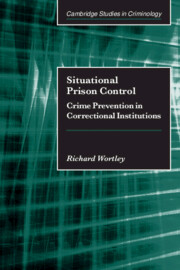Book contents
- Frontmatter
- Contents
- List of figures and tables
- Foreword
- Acknowledgements
- Part I Theoretical foundations
- 1 Introduction: why situational prison control?
- 2 Situational theories of prison behaviour
- 3 Situational methods of prison control
- 4 A model of situational prison control
- Part II Specific behaviours
- List of references
- Index
2 - Situational theories of prison behaviour
Published online by Cambridge University Press: 22 September 2009
- Frontmatter
- Contents
- List of figures and tables
- Foreword
- Acknowledgements
- Part I Theoretical foundations
- 1 Introduction: why situational prison control?
- 2 Situational theories of prison behaviour
- 3 Situational methods of prison control
- 4 A model of situational prison control
- Part II Specific behaviours
- List of references
- Index
Summary
Despite the traditional dominance of the person-centred focus in psychology and psychiatry, there is also a long history of the recognition of situational forces. Situational prevention is underpinned by a compelling body of research evidence on the crucial role of the person–situation interaction. This chapter reviews some of the psychological theories with significant situational components – behaviour theory, social learning theory, theories of social influence, frustration-aggression hypothesis, environmental psychology and rational choice perspective – highlighting the implications of these accounts for prison behaviour and its control.
Behaviour theory
Behaviour theory, of course, has always regarded the environment as the prime determinant of behaviour. However, in discussing behavioural explanations of crime, criminology texts have typically focused on the role of historical rather than immediate environments. That is, most attention has been given to the way that behavioural patterns and habits are acquired. In effect, behaviour theory has been treated little differently from traditional personality theories. The impression often conveyed is that individuals learn criminal habits that are internalised and then displayed in a more or less consistent manner. Changing criminal behaviour has been seen to involve for each individual offender the elimination of maladaptive behavioural patterns and the learning of new adaptive ones. Yet the immediate environment is crucial within the behavioural paradigm. When Pavlov conditioned his dogs to salivate at the sound of a bell, he not only demonstrated that reflex behaviour could be learned, but that performance of such behaviour was situationally dependent.
- Type
- Chapter
- Information
- Situational Prison ControlCrime Prevention in Correctional Institutions, pp. 15 - 35Publisher: Cambridge University PressPrint publication year: 2002



